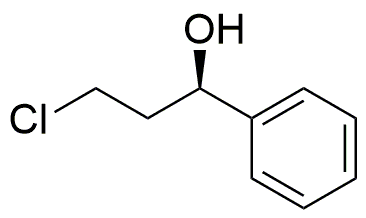(R)-(+)-3-Chloro-1-phenyl-1-propanol is widely utilized in research focused on:
- Synthesis of Pharmaceuticals: This compound serves as an important intermediate in the synthesis of various pharmaceutical agents, particularly in the production of chiral drugs that require specific stereochemistry for efficacy.
- Flavor and Fragrance Industry: It is used in the formulation of flavorings and fragrances, providing a unique aromatic profile that enhances the sensory experience of products like perfumes and food items.
- Research in Organic Chemistry: The compound is employed in organic synthesis as a building block, allowing chemists to create more complex molecules through various reactions, thus facilitating advancements in chemical research.
- Chiral Catalysis: It plays a role in asymmetric synthesis, where it can be used as a chiral catalyst or ligand, improving the selectivity and yield of desired products in chemical reactions.
- Material Science: This chemical is explored in the development of new materials, particularly in the creation of polymers with specific properties, which can be beneficial in various industrial applications.
General Information
Properties
Safety and Regulations
Applications
(R)-(+)-3-Chloro-1-phenyl-1-propanol is widely utilized in research focused on:
- Synthesis of Pharmaceuticals: This compound serves as an important intermediate in the synthesis of various pharmaceutical agents, particularly in the production of chiral drugs that require specific stereochemistry for efficacy.
- Flavor and Fragrance Industry: It is used in the formulation of flavorings and fragrances, providing a unique aromatic profile that enhances the sensory experience of products like perfumes and food items.
- Research in Organic Chemistry: The compound is employed in organic synthesis as a building block, allowing chemists to create more complex molecules through various reactions, thus facilitating advancements in chemical research.
- Chiral Catalysis: It plays a role in asymmetric synthesis, where it can be used as a chiral catalyst or ligand, improving the selectivity and yield of desired products in chemical reactions.
- Material Science: This chemical is explored in the development of new materials, particularly in the creation of polymers with specific properties, which can be beneficial in various industrial applications.
Documents
Safety Data Sheets (SDS)
The SDS provides comprehensive safety information on handling, storage, and disposal of the product.
Product Specification (PS)
The PS provides a comprehensive breakdown of the product’s properties, including chemical composition, physical state, purity, and storage requirements. It also details acceptable quality ranges and the product's intended applications.
Certificates of Analysis (COA)
Search for Certificates of Analysis (COA) by entering the products Lot Number. Lot and Batch Numbers can be found on a product’s label following the words ‘Lot’ or ‘Batch’.
*Catalog Number
*Lot Number
Certificates Of Origin (COO)
This COO confirms the country where the product was manufactured, and also details the materials and components used in it and whether it is derived from natural, synthetic, or other specific sources. This certificate may be required for customs, trade, and regulatory compliance.
*Catalog Number
*Lot Number
Safety Data Sheets (SDS)
The SDS provides comprehensive safety information on handling, storage, and disposal of the product.
DownloadProduct Specification (PS)
The PS provides a comprehensive breakdown of the product’s properties, including chemical composition, physical state, purity, and storage requirements. It also details acceptable quality ranges and the product's intended applications.
DownloadCertificates of Analysis (COA)
Search for Certificates of Analysis (COA) by entering the products Lot Number. Lot and Batch Numbers can be found on a product’s label following the words ‘Lot’ or ‘Batch’.
*Catalog Number
*Lot Number
Certificates Of Origin (COO)
This COO confirms the country where the product was manufactured, and also details the materials and components used in it and whether it is derived from natural, synthetic, or other specific sources. This certificate may be required for customs, trade, and regulatory compliance.


